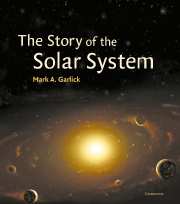Book contents
- Frontmatter
- Contents
- Miscellaneous Frontmatter
- Introduction
- Part 1 Genesis of the Sun and Solar Nebula
- Part 2 Emergence of the Sun's Family
- 2 200 000 years: Planetesimals and Protoplanets
- 2–3 million years: Gas Giants and Asteroids
- 3–10 million years: Ice Giants and Comets
- 3–10 million years: Regular Satellites
- 10–100 million years: Terrestrial Planets
- 100–1300 million years: The Heavy Bombardment
- 700–1300 million years: Building the Atmospheres
- 4500 million years? Formation of the Ring Systems
- 4660 million years: The Modern Solar System
- Part 3 Solar System Past and Present
- Part 4 End of an Era
- Glossary
- Index
4500 million years? Formation of the Ring Systems
from Part 2 - Emergence of the Sun's Family
Published online by Cambridge University Press: 10 November 2009
- Frontmatter
- Contents
- Miscellaneous Frontmatter
- Introduction
- Part 1 Genesis of the Sun and Solar Nebula
- Part 2 Emergence of the Sun's Family
- 2 200 000 years: Planetesimals and Protoplanets
- 2–3 million years: Gas Giants and Asteroids
- 3–10 million years: Ice Giants and Comets
- 3–10 million years: Regular Satellites
- 10–100 million years: Terrestrial Planets
- 100–1300 million years: The Heavy Bombardment
- 700–1300 million years: Building the Atmospheres
- 4500 million years? Formation of the Ring Systems
- 4660 million years: The Modern Solar System
- Part 3 Solar System Past and Present
- Part 4 End of an Era
- Glossary
- Index
Summary
With the emergence and subsequent evolution of the planetary atmospheres, the Solar System was almost complete. Only two things remained to be added: the rings of the giant planets, and some of the smaller, irregular satellites. The irregular satellites were probably acquired early in the history of the Solar System, when the giant planets captured icy planetesimals from the thinning Solar Nebula. Some are no doubt of more recent origin. The origins of the rings, however, are more difficult to pin down.
The most famous ring system is Saturn's. Consisting of countless boulder-sized, and smaller, icy chunks in individual orbits about the planet, the rings are exceedingly thin – with relative dimensions like those of a sheet of paper the size of a football pitch. But Saturn is not alone, because each of the other giant planets has similar accoutrements, albeit with different characteristics. Indeed, research has shown that no two systems are alike: they differ from each other in terms of diameter, brightness, and in the sizes and compositions of the particles that constitute them. This is a clue to their formation. But the biggest hint is that most of the rings surround their planetary hosts inside their respective ‘Roche limits’. This is the distance from a given planet at which gravitational forces tear apart any body held together mostly by gravity. These clues could mean that the rings are the unassembled ruins of moons that strayed within this danger zone and got ripped to shreds, or the remains of comets that got too close and suffered a similar fate.
- Type
- Chapter
- Information
- The Story of the Solar System , pp. 40 - 41Publisher: Cambridge University PressPrint publication year: 2002



